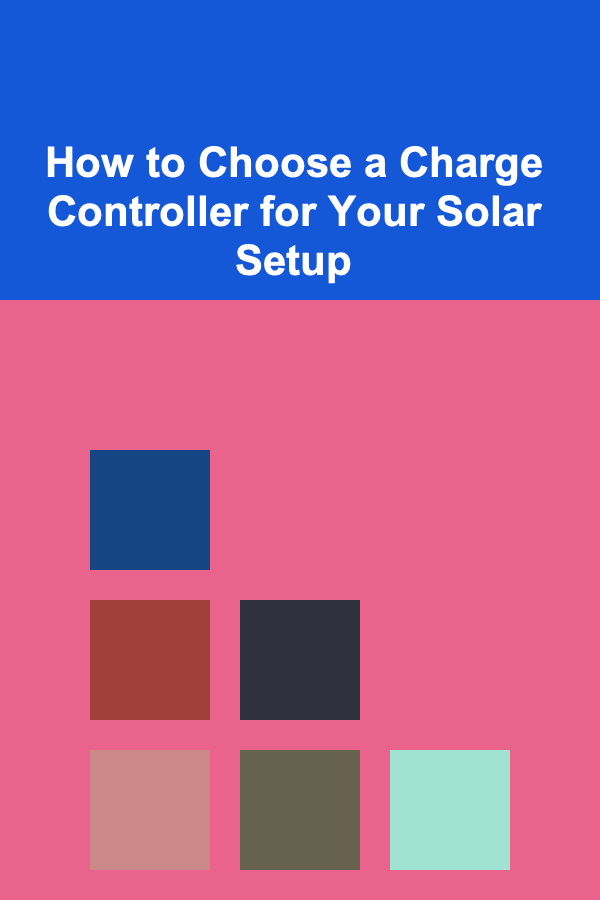
How to Choose a Charge Controller for Your Solar Setup
ebook include PDF & Audio bundle (Micro Guide)
$12.99$6.99
Limited Time Offer! Order within the next:

When setting up a solar power system, whether for a small off-grid cabin or a larger, more complex installation, one of the critical components that often doesn't get the attention it deserves is the charge controller. A charge controller plays a vital role in regulating the voltage and current coming from your solar panels to the batteries, ensuring that your energy storage system is properly maintained, preventing overcharging, and extending the lifespan of your batteries. Choosing the right charge controller is essential to optimizing the performance of your solar setup.
This comprehensive guide will walk you through everything you need to know about selecting the appropriate charge controller for your solar power system, covering key factors like types, sizing, compatibility, and advanced features.
What is a Charge Controller?
A charge controller is an essential device in a solar power system, designed to regulate the flow of energy from the solar panels to the battery bank. Its primary function is to ensure that the batteries are charged properly and efficiently, preventing overcharging or undercharging, which can reduce battery lifespan and efficiency.
Without a charge controller, the voltage and current coming from the solar panels can fluctuate, which could potentially cause damage to the batteries. Essentially, the charge controller acts as a "traffic cop," managing the flow of electricity to ensure that the system remains balanced and operates within safe parameters.
Types of Charge Controllers
Before delving into how to choose the best charge controller for your solar system, it's important to understand the two primary types of charge controllers available on the market: PWM (Pulse Width Modulation) and MPPT (Maximum Power Point Tracking).
1. PWM Charge Controllers
PWM charge controllers are simpler, older technology compared to MPPT controllers. They function by gradually reducing the amount of power being sent to the batteries as they approach a full charge. The controller works in stages, allowing the charging current to be slowly tapered off as the battery bank reaches its voltage limit.
Pros of PWM Charge Controllers:
- Cost-effective: PWM controllers are less expensive than MPPT controllers, making them an attractive option for smaller, budget-conscious systems.
- Simplicity: They are straightforward to install and maintain, making them ideal for users with limited technical expertise.
- Reliability: Due to their simple design, PWM controllers tend to be very reliable with fewer components that can fail.
Cons of PWM Charge Controllers:
- Less efficient: PWM controllers are less efficient in converting solar panel power into usable energy, especially when the voltage from the solar panel is higher than the battery bank voltage.
- Not ideal for large systems: For larger, more complex systems where solar panels are operating at high voltages, PWM controllers may not be able to extract the maximum amount of power from the panels.
2. MPPT Charge Controllers
MPPT charge controllers are a more advanced technology that continuously monitors and adjusts the power coming from the solar panels to maximize energy conversion. MPPT controllers are more efficient at managing the energy produced by solar panels, especially when the voltage of the solar panel is higher than the voltage of the battery bank. They can track the maximum power point (hence the name) of the solar panel and adjust the current accordingly, extracting more power even in less-than-ideal conditions.
Pros of MPPT Charge Controllers:
- Higher efficiency: MPPT controllers can increase the efficiency of your solar system by 20-30%, or even more, when compared to PWM controllers. This makes them ideal for systems with larger solar panels and higher voltage configurations.
- Maximized energy harvesting: MPPT controllers can extract more power from the panels, especially in scenarios where the sunlight is inconsistent, which leads to better performance in partial shading or cloudy weather.
- Better for larger systems: MPPT controllers are designed for larger solar installations, where maximizing energy production is crucial.
Cons of MPPT Charge Controllers:
- Higher cost: MPPT controllers are more expensive than PWM controllers, and this price difference may not be justified for smaller, less complex systems.
- Complexity: MPPT controllers are more sophisticated and may require more knowledge to install and troubleshoot.
Factors to Consider When Choosing a Charge Controller
When selecting a charge controller for your solar setup, it's important to consider a variety of factors to ensure compatibility, efficiency, and reliability. Here are the key considerations you need to take into account:
1. Battery Type
The type of battery you are using in your solar setup will greatly influence your choice of charge controller. Different types of batteries require different charging methods and voltage levels.
- Flooded Lead-Acid (FLA) Batteries: These are traditional lead-acid batteries, often used in off-grid solar applications. They require specific charging profiles, which can be provided by most PWM and MPPT controllers.
- Sealed Lead-Acid (SLA) Batteries: SLA batteries, including AGM and Gel types, are sealed and require slightly different charging voltages and currents. Make sure the charge controller supports this type of battery.
- Lithium-Ion Batteries: Lithium-ion batteries are increasingly popular in solar systems due to their efficiency and longevity. These batteries require very specific charging profiles that are often available in MPPT controllers but may not be supported by all PWM controllers.
- Nickel-Based Batteries: Some solar systems use nickel-based batteries like NiFe. Make sure the charge controller is compatible with this type, as it requires specialized charging parameters.
2. System Voltage
The voltage of your solar panel system plays a major role in determining the charge controller you choose. Most solar systems are either 12V, 24V, or 48V systems, and your controller needs to be compatible with the voltage of both the solar array and the battery bank.
- 12V Systems: These are typical for small residential or recreational setups.
- 24V Systems: Ideal for medium-sized systems, offering more efficiency than 12V setups.
- 48V Systems: Large, high-power systems usually use 48V systems for greater efficiency and to handle higher energy needs.
When selecting a charge controller, make sure it supports the system voltage you are using, as mismatch can lead to inefficiency or damage to your equipment.
3. Solar Panel Wattage
The total wattage of your solar panel array will help determine the capacity of the charge controller you need. Charge controllers are rated by the amount of power they can handle, usually measured in watts (W) or amperes (A).
For example, if you have a 500W solar array, you need to choose a charge controller that can handle at least 500W of power. For larger arrays, you may need to combine multiple charge controllers or choose a higher-rated unit.
4. Maximum Current and Voltage
When selecting a charge controller, ensure that it can handle the maximum current and voltage that your solar panel array will produce. Overloading a charge controller can lead to overheating, damage, or failure of the system.
Charge controllers typically come with a maximum input current rating, so be sure to select a controller with a slightly higher current rating than the output of your solar panel array. Similarly, ensure the voltage limits are compatible with your panel's open-circuit voltage (Voc).
5. Efficiency
Efficiency is a key factor in maximizing the performance of your solar system. MPPT controllers are generally much more efficient than PWM controllers, particularly when you have large or high-voltage solar panels. The efficiency of a charge controller determines how much of the solar power it can convert into usable energy for your battery bank.
In a setup with high-quality, high-efficiency solar panels, an MPPT controller is often the best choice, as it can take advantage of the excess energy that might otherwise go to waste with a PWM controller.
6. Features and Options
Charge controllers come with a variety of features that can improve the performance and usability of your solar system. Here are some options to consider:
- Display/Monitoring: Some charge controllers come with built-in displays or the option to connect to external monitoring systems, allowing you to track solar panel performance, battery charge levels, and other metrics in real-time.
- Temperature Compensation: Temperature affects the charging characteristics of batteries. Charge controllers with temperature compensation adjust the charging parameters based on the temperature of the battery, preventing overcharging or undercharging due to extreme conditions.
- Load Control: Some charge controllers can also control the power sent to connected loads (e.g., lights, appliances). This feature is particularly useful in off-grid systems, where you may need to conserve energy and prevent draining the battery too quickly.
7. Cost vs. Benefit
While MPPT charge controllers offer higher efficiency and better performance, they come at a higher initial cost. If you are working with a limited budget and only have a small solar system, a PWM controller might be a more cost-effective choice.
However, if you plan to expand your system or want to ensure the most efficient use of your solar panels, investing in an MPPT controller might be worthwhile in the long run. Consider the overall cost of the controller relative to the size and future growth of your solar power system.
8. Durability and Warranty
Like any piece of equipment, a charge controller should be durable and reliable, especially if it is exposed to harsh outdoor conditions. Look for controllers with weatherproof or sealed enclosures that can withstand dust, moisture, and other environmental factors.
Check the manufacturer's warranty and support options as well. A longer warranty period typically indicates a higher level of quality and assurance of performance.
Conclusion
Choosing the right charge controller for your solar setup is crucial for ensuring the longevity and efficiency of your system. Whether you opt for a cost-effective PWM controller or a more efficient MPPT model, it's essential to carefully evaluate your system's needs, including battery type, voltage, current, and panel wattage.
By understanding the different types of controllers and considering the factors outlined in this guide, you can make an informed decision that will enhance the performance of your solar power system, saving you money and extending the lifespan of your equipment. With the right charge controller in place, your solar setup will run smoothly and efficiently for years to come.

How to Create a Cleaning Supplies Station in Your Bathroom
Read More
How to Organize Your Digital Files for Better Productivity
Read More
How to Protect Earth from Asteroids
Read More
How to Throw a Fun and Relaxed Brunch Party at Home
Read More
How To Identify and Eliminate Time Wasters
Read More
Geocaching for Beginners: Essential Gear and Skills
Read MoreOther Products

How to Create a Cleaning Supplies Station in Your Bathroom
Read More
How to Organize Your Digital Files for Better Productivity
Read More
How to Protect Earth from Asteroids
Read More
How to Throw a Fun and Relaxed Brunch Party at Home
Read More
How To Identify and Eliminate Time Wasters
Read More